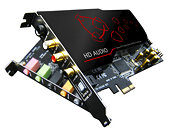Wednesday, April 16th 2014
Aim Launches SC808 7.1-channel PCIe Sound Card
Taiwanese PC audio hardware manufacturer Aim launched its flagship consumer sound card, the SC808. This full-height dual-slot (with daughterboard) sound card features PCI-Express x1 bus interface, and offers 7.1-channel analog and digital outputs. At its heart is C-Media's CMI8888, which is a native PCIe HDA controller, giving external DACs the task of handling analog outputs. The primary 2-channel headphones output is driven by a Wolfson WM8741 DAC, which offers a stellar SNR of 128 dBA. Other analog channels (center/sub, rear, sides), are handled by a C-Media CMI9882A CODEC, which offers a reasonable 100 dBA.
At the downstream of the WM8741 is the card's headphones amp circuit, featuring socketed Texas Instruments LM4562 OPAMP chips, metalized polypropylene capacitors, and a swappable pre-amp stage. The main PCB of the card holds a 6.3 mm stereo headphones jack, left and right RCA line-outs, 7.1-channel coaxial, and optical/TOSLINK SPDIF outputs. The other multi-channel analog outs are wired out by a header and ribbon cable to the daughterboard, which holds color-coded 3.5 mm jacks to all the channels. All audio portions of the card feature electrolytic capacitors (except the OPAMP stages, which feature MP caps), only the electrical/VRM portion of the card features conductive polymer (solid-state) capacitors. The card draws power from a 4-pin Molex power connector. On the software side of things, the driver provider is C-Media, with its reference Xear3D control panel. The card supports Windows 8. Slated for an April 24th launch in Japan, it's expected to be priced at 12,000¥ (US $112). Given its hardware, that's a reasonable price.
Source:
Hermitage Akihabara
At the downstream of the WM8741 is the card's headphones amp circuit, featuring socketed Texas Instruments LM4562 OPAMP chips, metalized polypropylene capacitors, and a swappable pre-amp stage. The main PCB of the card holds a 6.3 mm stereo headphones jack, left and right RCA line-outs, 7.1-channel coaxial, and optical/TOSLINK SPDIF outputs. The other multi-channel analog outs are wired out by a header and ribbon cable to the daughterboard, which holds color-coded 3.5 mm jacks to all the channels. All audio portions of the card feature electrolytic capacitors (except the OPAMP stages, which feature MP caps), only the electrical/VRM portion of the card features conductive polymer (solid-state) capacitors. The card draws power from a 4-pin Molex power connector. On the software side of things, the driver provider is C-Media, with its reference Xear3D control panel. The card supports Windows 8. Slated for an April 24th launch in Japan, it's expected to be priced at 12,000¥ (US $112). Given its hardware, that's a reasonable price.

10 Comments on Aim Launches SC808 7.1-channel PCIe Sound Card
The spec sheet states that the headphone amp has 75 mW output power. I have no idea how much is needed for those high-end heaphones, but I'm hoping that is enough for those of us who enjoy quality headphones.
I'm wondering if the drivers allow bass redirection and cutoff. It would be a shame if it didn't. About them drivers... The soundcard drivers page lists the latest drivers release in 2012. Now, I don't wanna sound pessimistic, but this smells like yet another case of "good hardware with slow software support." I'm aware that, if the drivers are good, it doesn't really matter if they're old, but, having been burnt by Asus myself, it's hard for me to shake off the thought...
Im curious how the card performs but I had issues with games not liking the STX even when i had hardware acceleration turned of due poor implementation of Xear3D - ARMA II would just sound real loud and distort even if i turned the ingame audio down. guildwars and any EAX related game titles would just eventually CTD with EAX related driver issues and id suffer from sound anomalies like being able to hear footsteps or gunshots from enemy spawn in counter strike.
^ all this was happening even with 3rd party drivers, They did fix a lot of compatibility with games though.
Im more then happy with my SB-Z
It is when you use headphones and analog connection that would see an improvement.
I'm happy with my Audiotrak Prodigy Cube.